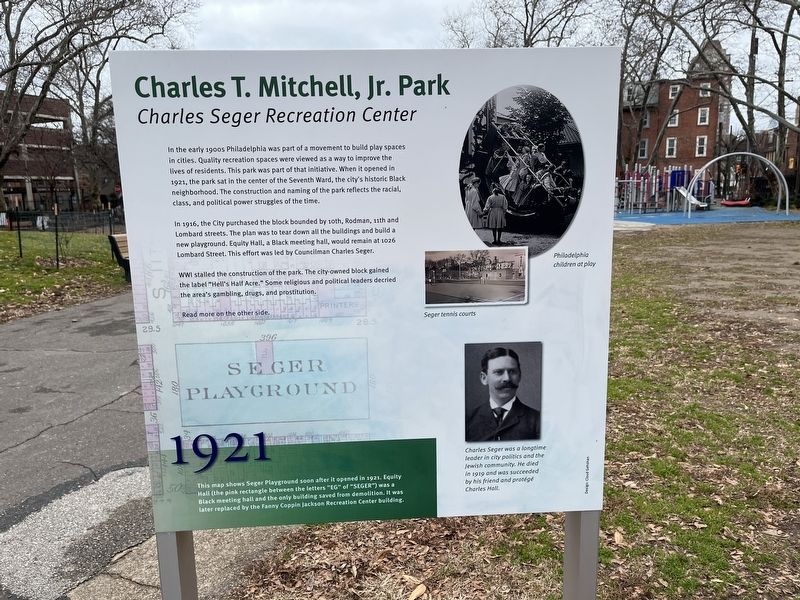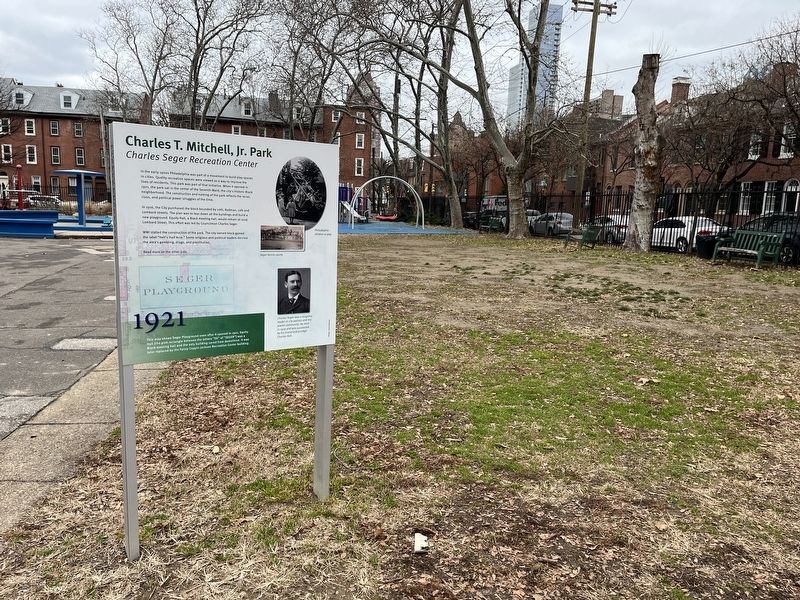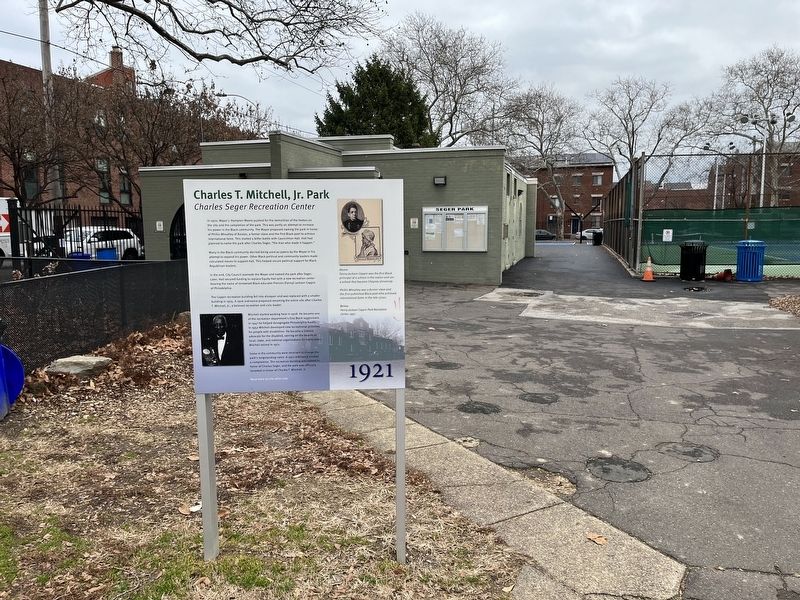Washington Square West in Philadelphia in Philadelphia County, Pennsylvania — The American Northeast (Mid-Atlantic)
Charles T. Mitchell, Jr. Park
Charles Seger Recreation Center
— 1921 —
In the early 1900s Philadelphia was a part of a movement to build play spaces in cities. Quality recreation spaces were viewed as a way to improve the lives of residents. This park was part of that initiative. When it opened in 1921, the park sat in the center of the Seventh Ward, the city's historic Black neighborhood. The construction and naming of the park reflects the racial, class, and political power struggles of the time.
In 1916, the City purchased the block bounded by 10th, Rodman, 11th and Lombard streets. The plan was to tear down all the buildings and built a new playground. Equity Hall, a Black meeting hall, would remain at 1026 Lombard Street. This effort was led by Councilman Charles Seger.
WWI stalled the construction of the park. The city-owned block gained the label "Hell's Half Acre." Some religious and political leaders decried the area's gambling, drugs, and prostitution.
[Captions:]
This map shows Seger Playground soon after it opened in 1921. Equity Hall (the pink rectangle between the letters "EG" of "SEGER") was a Black meeting hall and the only building saved from demolition. It was later replaced by the Fanny Coppin Jackson Recreation Center building.
Charles Seger was a longtime leader in city politics and the Jewish community. He died in 1919 and was succeeded by his friend and protégé Charles Hall.
In 1920, Mayor J. Hampton Moore pushed for the demolition of the homes on the site and the completion of the park. This was partly an attempt to increase his power in the Black community. The Mayor proposed naming the park in honor of Phillis Wheatley of Boston, a former slave and the first Black poet to achieve international fame. This started a bitter battle with Councilman Hall. Hall had planned to name the park after Charles Seger, "the man who made it Happen."
Many in the Black community decried being used as pawns by the Mayor in his attempt to expand his power. Other Black political and community leaders made calculated moves to support Hall. this helped secure political support for Black Republican leaders.
In the end, City Council overrode the Mayor and named the park after Seger. Later, Hall secured funding to replace Equity Hall with a new recreation center bearing the name of renowned Black educator Frances (Fanny) Jackson Coppin of Philadelphia.
The Copping recreation building fell into disrepair and was replaced with a smaller building in 1974. A 1976 ordinance proposed renaming the entire site after Charles T. Mitchell, Jr., a beloved recreation and civic leader.
Mitchell started working here in 1928.
![Charles T. Mitchell, Jr. Park Marker [Reverse]. Click for full size. Charles T. Mitchell, Jr. Park Marker [Reverse] image. Click for full size.](Photos7/700/Photo700718.jpg?116202345200PM)
Photographed By Devry Becker Jones (CC0), January 13, 2023
2. Charles T. Mitchell, Jr. Park Marker [Reverse]
Some in the community were reluctant to change the park's longstanding name. A 1977 ordinance created a compromise. The recreation building was named in honor of Charles Seger, and the park was officially renamed in honor of Charles T. Mitchell, Jr.
[Captions:]
Above:
Fanny Jackson Coppin was the first Black principal of a school in the nation and ran a school that became Cheyney University.
Phillis Wheatley was a former slave and the first published Black poet who achieved international fame in the late 1700s.
Fanny Jackson Coppin Park Recreation Center, 1957
Erected by City of Philadelphia.
Topics. This historical marker is listed in these topic lists: African Americans • Government & Politics • Parks & Recreational Areas. A significant historical year for this entry is 1921.
Location. 39° 56.625′ N, 75° 9.558′ W. Marker is in Philadelphia, Pennsylvania, in Philadelphia County
Other nearby markers. At least 8 other markers are within walking distance of this marker. Jacob C. White Jr. (within shouting distance of this marker); Elizabeth Taylor Greenfield (within shouting distance of this marker); Benjamin Banneker Institute (about 300 feet away, measured in a direct line); Engine Company No. 11 (about 300 feet away); Henry George (about 400 feet away); Louis I. Kahn Park / How this site became Louis I. Kahn Park (about 500 feet away); Standard Theatre (about 500 feet away); William Whipper (about 500 feet away). Touch for a list and map of all markers in Philadelphia.
Credits. This page was last revised on February 2, 2023. It was originally submitted on January 16, 2023, by Devry Becker Jones of Washington, District of Columbia. This page has been viewed 90 times since then and 25 times this year. Photos: 1, 2, 3, 4. submitted on January 16, 2023, by Devry Becker Jones of Washington, District of Columbia.


